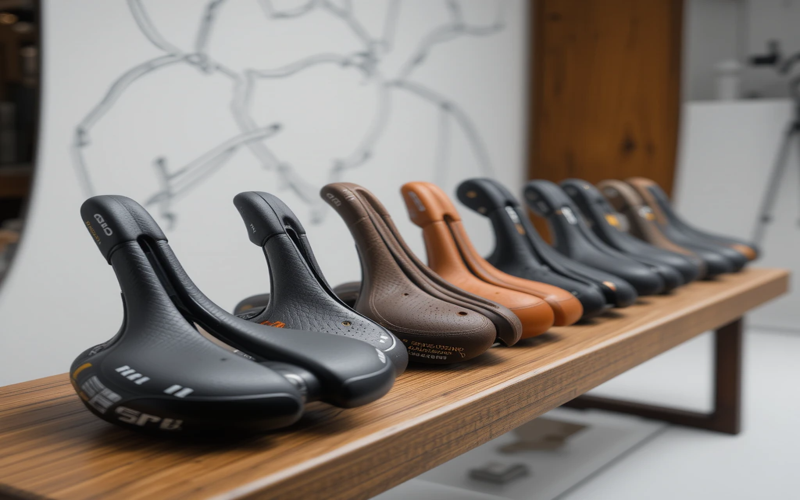1. Introduction
Finding the best road bicycle saddles is crucial for every cyclist looking to enhance comfort and performance during long rides. Whether you’re searching for the most comfortable road bike saddle or the best women’s bike saddle for long-distance, the right saddle can make all the difference in preventing discomfort and improving your cycling experience. In this article, we’ll explore top saddle options, key features to consider, and expert reviews—including the popular Ergon saddles review—to help you choose the perfect saddle for your needs. From indoor trainer setups to endurance road cycling, this guide covers everything you need to know to ride comfortably and confidently.

Table of Contents
2. Why Choosing the Right Road Bike Saddle Matters
- A properly fitted road bike saddle improves overall comfort, especially on long-distance rides, by reducing pressure on sensitive areas.
- The right saddle enhances cycling performance by supporting efficient pedaling posture and minimizing unnecessary body movement.
- Poor saddle fit can lead to saddle pain, numbness, and long-term discomfort, often discouraging regular riding.
- Choosing the correct width and shape ensures proper sit bone support, which helps prevent injuries and muscle strain.
- Saddles designed with pressure relief features, such as cut-outs or ergonomic contours, significantly reduce cycling discomfort.
- A well-matched saddle improves rider stability, allowing better bike control and confidence during climbs or sprints.
- For endurance cyclists, the right saddle can delay fatigue and reduce the risk of saddle sores on long rides.
- Selecting a high-quality saddle with suitable materials contributes to durability and consistent support over time.
- Riders using indoor trainers or stationary bikes benefit from saddles with added breathability and cushioning to offset static positioning.
3. Key Factors to Consider When Buying a Road Bike Saddle
- Saddle shape affects rider flexibility and movement; flat saddles suit flexible riders, while curved saddles offer stability for less flexible cyclists.
- Width and sit bone fit are crucial for comfort—choose a saddle that supports your sit bones without causing pressure on soft tissue.
- Padding type matters—foam is lightweight and firm for performance, while gel offers softer support for casual and endurance riders.
- Cut-out shapes or pressure-relief channels are designed to reduce numbness and enhance circulation, especially on extended road rides.
- Saddle material influences weight, comfort, and durability; carbon rails reduce weight, while synthetic covers resist weather and wear.
- Weight of the saddle is important for competitive riders—lighter saddles improve climbing and overall bike performance.
- Compatibility with indoor trainers should be considered—look for breathable, cushioned models to handle sweat and static riding positions.
- Riding style and discipline influence saddle choice; racing, endurance, and commuting each benefit from different ergonomic designs.
- Adjustment options like tilt, height, and fore-aft position are essential to fine-tune comfort and eliminate saddle discomfort.
4. Best Road Bicycle Saddles [Editor’s Picks for 2025]
- Fizik Arione R3 – Ideal for flexible riders, this lightweight saddle offers a long, flat profile and responsive foam padding for performance-oriented road cyclists.
- Selle Italia SLR Boost Superflow – Features a compact design with a large central cut-out to relieve pressure and enhance comfort on long-distance rides.
- Ergon SR Road Comp Men – Engineered for male anatomy, this saddle combines orthopedic foam with a flat rear for improved support and power transfer.
- Prologo Dimension Nack – Compact and short-nose, it provides excellent pressure relief and support for aggressive riding positions.
- Selle Royal Respiro Moderate – A great choice for endurance and touring cyclists seeking added gel padding, airflow channels, and comfort on long rides.
- Specialized Power Expert – Known for its wide nose and firm padding, it offers stability and reduced numbness for competitive road cyclists.
- Terry Fly Ti Gel – A popular saddle for long-distance cyclists, it features gel inserts, a center relief channel, and a vibration-dampening design.
5. Ergon Saddles Review: Are They Worth It?
- Ergon saddles are designed with ergonomics in mind, reducing pressure and enhancing support for road and mountain bike riders.
- Models like the Ergon SR and SM series are tailored to male and female anatomy, promoting better fit and long-distance comfort.
- The SR Road series offers a flat profile and pressure-relief channel, ideal for performance-focused road cyclists.
- Ergon uses orthopedic foam and gel inserts to provide support without adding excess bulk, ensuring comfort without compromising weight.
- Riders report noticeable relief from numbness and saddle discomfort, especially on endurance rides and indoor trainer sessions.
- The build quality and durable materials make Ergon saddles a reliable long-term investment for cyclists seeking consistent performance.
- Available in multiple widths, Ergon saddles support proper sit bone alignment and help prevent common saddle-related pain.
- While slightly more expensive than entry-level options, the performance and comfort gains make Ergon saddles worth the price for many riders.
- Overall, Ergon saddles are a top-rated choice for riders prioritizing pressure relief, anatomical fit, and endurance-focused design.
6. Best Women’s Bike Saddle for Long-Distance Comfort
- Women’s bike saddles are specifically designed with a wider rear section and pressure-relief channels to match female anatomy and reduce discomfort.
- The Selle Italia Diva Gel Flow is a top pick for long-distance female cyclists, offering gel padding, a large central cut-out, and excellent shock absorption.
- The Ergon SR Women series features a gender-specific shape and orthopedic foam padding designed to reduce soft tissue pressure and eliminate numbness during long rides.
- Terry Butterfly Century combines multi-density foam and a wider platform, ideal for endurance rides and bike touring.
- A properly fitted women’s saddle can improve pelvic support, posture, and blood flow, especially during extended road cycling sessions.
- Female riders benefit from saddles with shorter nose lengths and strategic padding, which help reduce friction and increase comfort over time.
- Choosing a saddle that aligns with your sit bone width and riding style is essential for preventing pain on long rides.
- The best women’s bike saddles balance support, pressure relief, and weight, making them suitable for both competitive and recreational cyclists.
7. Best Saddle for Indoor Trainers and Stationary Bikes
- Indoor cycling places more pressure on the saddle due to a static riding position, making comfort and support essential.
- The best saddle for indoor trainer use should have extra padding or gel inserts to reduce discomfort during long, seated sessions.
- Breathable saddle covers and moisture-wicking materials help manage sweat buildup and prevent skin irritation.
- Short-nose designs with a wide rear profile offer better support and minimize soft tissue pressure on stationary bikes.
- The Selle Royal Respiro is a popular indoor option, known for its ventilation channels and high-density foam.
- Ergon SR Allroad Core saddles provide shock absorption and support for riders using indoor trainers or smart bikes.
- A saddle with a central relief channel or cut-out is ideal for minimizing numbness and maintaining blood flow during static training.
- Choosing a saddle compatible with your trainer setup and riding posture is key to avoiding pressure points and long-term discomfort.
- For extended indoor workouts, comfort-focused saddles can significantly improve consistency and reduce recovery time.
8. Most Comfortable Road Bike Saddles for Long Rides
- Comfort is paramount for long rides, making saddle choice critical to prevent pain and fatigue over extended distances.
- The most comfortable road bike saddles typically feature pressure relief cut-outs or channels to reduce numbness and improve blood circulation.
- High-density foam or gel padding offers a balance between support and cushioning without compromising performance.
- Wider saddle designs that fit sit bone width help distribute weight evenly, reducing pressure points during long rides.
- Popular options like the Selle Italia SLR Kit Carbonio and Specialized Power Arc are favored for their ergonomic shapes and durable materials.
- Saddles with ergonomic contours promote better posture and reduce lower back strain, essential for endurance cycling.
- Breathable materials and moisture-wicking covers enhance comfort by managing sweat and reducing friction.
- Riders often report improved ride quality and less saddle soreness when switching to saddles designed specifically for long-distance comfort.
- Proper saddle fit combined with quality padding ensures sustained comfort and performance during extended road cycling sessions.
9. Saddle Fit and Comfort Tips for Road Cyclists
- Accurately measuring your sit bone width is crucial for choosing a saddle that offers optimal support and minimizes discomfort.
- Adjusting saddle height ensures efficient pedaling and reduces knee strain, contributing to overall ride comfort.
- Proper saddle tilt, usually level or slightly nose-down, helps avoid excessive pressure on soft tissues and improves blood flow.
- Fore-aft saddle positioning affects weight distribution; moving the saddle forward or backward can enhance pedaling efficiency and comfort.
- Signs of poor saddle fit include numbness, chafing, and persistent pain, indicating a need for adjustment or a different saddle model.
- Regularly checking saddle rails and clamp tightness maintains correct positioning and prevents unwanted movement during rides.
- Using padded cycling shorts can complement a well-fitted saddle to reduce friction and enhance comfort on long rides.
- Professional bike fitting services can optimize saddle position and fit, improving posture and reducing injury risk.
- Understanding pressure zones and saddle design helps riders choose a model tailored to their anatomy and cycling style.
10. Conclusion
Choosing the best road bicycle saddles is essential for maximizing comfort, performance, and injury prevention on every ride. Whether you are searching for the most comfortable road bike saddle for long rides or a best women’s bike saddle for long-distance comfort, selecting the right fit and features makes all the difference. Consider factors like saddle shape, padding, and cut-out designs to reduce pressure and improve blood flow. For indoor cycling enthusiasts, opting for the best saddle for indoor trainer ensures comfort during static sessions. Ultimately, investing in a quality saddle tailored to your anatomy and riding style will enhance your cycling experience and help you enjoy every mile with ease. Don’t hesitate to try different models or consult a professional bike fitter to find the ideal saddle that supports your long-distance cycling goals.
11. FAQs
Q1: Which road bike saddle provides the highest level of comfort for long-distance rides?
The most comfortable saddles for long rides typically feature pressure relief cut-outs, adequate padding like gel or high-density foam, and are tailored to fit your sit bone width, helping to reduce numbness and soreness over time.
Q2: How do I know if my road saddle fits correctly?
A proper fit means your sit bones are fully supported, you experience no numbness or pain during rides, and your saddle height and tilt allow efficient pedaling without excessive pressure on soft tissues.
Q3: Are women’s road bike saddles really different from men’s?
Yes, women’s saddles are designed with wider rear sections, shorter noses, and specific pressure relief zones to better accommodate female anatomy, improving comfort on long-distance rides.
Q4: What’s the difference between indoor and outdoor bike saddles?
Indoor bike saddles often have extra padding, breathable materials, and designs that accommodate static positions, whereas outdoor saddles focus more on lightweight materials and aerodynamic shapes.
Q5: How much time does it usually take to fully break in a new bike saddle?
Breaking in a saddle usually takes between 50 to 100 miles, depending on the saddle material and your riding style.
